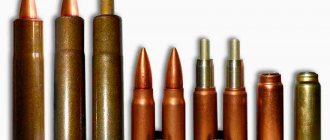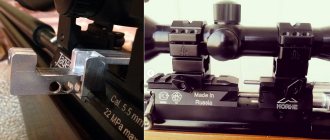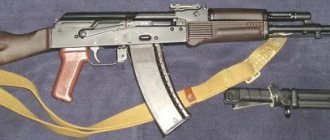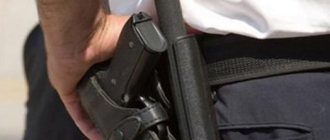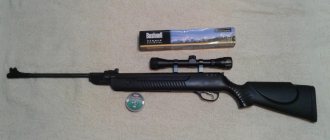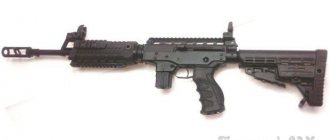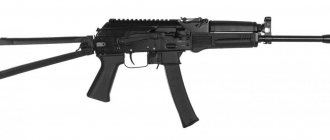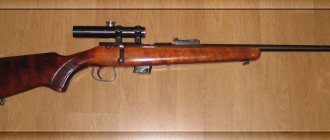During the development of a rifle for clay pigeon shooting, any decision made by designers strongly depends on the conditions under which the rifle for clay pigeon shooting will be used, or, in other words, on the technical features of the chosen sporting discipline of clay pigeon shooting.
Sporting differs from all other sports and hunting shooting exercises in the absolute variety of target trajectories. Shooting from a sporting weapon is carried out offhand, both at the shortest and longest distances, bordering on the functionality of the gun (60–65 m).
The sporting shotgun is a model of versatility. His typical portrait looks like this. This is a gun with a vertical barrel arrangement, having a length of 710 to 860 mm, and, as a rule, with interchangeable choke constrictions. The firing mechanism has one trigger and a selector for changing the order of the shot from the upper or lower barrel. These technical features help optimize the shot. The cylindrical choke, thanks to the wide shot pattern, ensures reliable target engagement at close ranges, and the maximum narrowing provides the required shot density at extreme shooting distances.
Shotguns for skeet shooting , as a rule, are equipped with a full set of narrowings for each barrel. From cylindrical to full choke (1 mm) in 0.2 or 0.25 mm increments. In addition to these standard sizes, some companies offer a reinforced 1.25 mm choke as an additional option for maximum long-range shots.
What is clay pigeon shooting?
Skeet shooting is a type of shooting sport using smoothbore shotguns of no more than 12 gauge and shotgun cartridges (pellet diameter no more than 2.5 mm). It is included in the program of the Olympic Games and is considered one of the oldest.
The main goal of the shooter is to hit the plate in such a way that the visible part of it breaks off from the base. Targets are thrown into the air using throwing machines. Competitions take place in special open areas.
3) Read owner reviews
It will definitely come in handy to study reviews from owners of the weapon you have chosen. But it should be understood that a person almost never perceives his own weapon neutrally and without emotion. People tend to justify their choices even to themselves, so very positive reviews must be “divided by two.”
Forums allow you to get answers to any questions you may have. No one can advise you better than gun owners themselves.
Find information about the problems that arise with weapons, read whether they are easy to solve. It is very important to be aware of the quality of work of salespeople and dealers. A lot depends on them: sales, repairs, ordering additional equipment, and the like.
Reviews from those who already own the gun you want to purchase are a surprisingly valuable source of information.
Types of skeet shooting: classic Olympic events
Skeet shooting can be divided into three groups: skeet, trap and sporting. The Olympic program includes competitions in two disciplines: skeet and trap. Double trap has been part of the Games program since 1996 and was excluded by decision of the IOC from the program of the 2022 Olympic Games in Tokyo.
Round stand (skete)
The exercise is performed on a platform with eight shooting ranges. They are located in a semicircle from the first number to the seventh, the eighth is located in the center (opposite the fourth). Targets are produced by two throwing machines. One of them is in a tower (3 m), the other in a booth (1 m). They are located at opposite ends of the semicircle at a distance of 40 meters.
The flight of targets on a round stand has a constant direction and speed (unlike a trench stand). Regardless of the place of departure (booth or tower), the targets do not change their trajectory, as they must fly through a tuning ring with a diameter of 90 cm.
Shooting at the monastery is carried out offhand. The shooter must hold the weapon at waist level before launching the target.
Trench stand (ladder)
In this exercise, shooting is carried out at targets that alternately fly out of fifteen cars. They are located in a trench under the shooting platform 15 meters from the shooting number. Opposite each number there are three cars, i.e. each room is oriented towards its own three plates. The target moves away from the shooter along fifteen different trajectories: five oriented to the right, five to the left and five straight (with a deviation of up to 45° and different flight altitudes).
Trench stand (double ladder)
Unlike the ladder, three throwing machines are used here instead of fifteen (7th, 8th, 9th). Shooting is performed at paired targets (doublet). There are several schemes for setting the flight trajectory of targets: A, B, C. At the shooter’s command, they fly out from the same place according to a scheme unknown to the athlete.
Features of the geometry of a shotgun
Modern weapons companies pay serious attention to the ergonomics of skeet shooting weapons. The main goal is to achieve maximum compliance of the geometry of the gun with the specifics of shooting exercises and the anthropometric characteristics of the shooter.
The most important element of this conformity is the stock. In fact, it becomes an adapter between the gun and the person, and at the same time the main criterion for comfort.
All shotguns for clay pigeon shooting can be divided into two groups. The first is a weapon designed for shooting offhand. It is used in exercises: “sporting”, “compact sporting”, “skeet”, “northern ladder”, “universal ladder”, “propellers” and some others. The second group is weapons for the “Olympic trap” and “American trap” exercises. In these exercises, the gun is placed in the shoulder while preparing to fire. These seemingly insignificant factors make significant adjustments to the geometry of the guns. The fundamental difference lies in such a parameter as the loss of the stock (butt).
Butt died
The tilt of the stock relative to the axis of the sighting bar is usually called “deflection”. It can be determined by the distance from the axis of the aiming bar to the ridge line of the butt at the rear and front points. The adaptability of a gun is an individual and even rather subjective concept. A gun that was ideally tailored for a specific athlete for trap (trench) shooting will not suit him at all for sporting, and vice versa. And this is determined primarily by the death of the butt.
Features of the butt of a rifle butt for a trench stand
To hit the plate, the shooter must take the necessary lead. The plate on the trench stand flies from bottom to top and, accordingly, the athlete has to shoot above it. Thus, it turns out that when the shot occurs, the target will be under the barrels and out of the shooter’s field of view. To prevent this from happening, weapons for the trench stand are made with a low butt drop (high comb). The height of the stock ridge at the front point is 25-35 mm, at the rear - 36-49 mm. With such a height, it is possible to ensure that the athlete looks at the top of the aiming bar and the shot will occur with the necessary lead with precise control of the plate.
Features of the butt of a sporting shotgun
The loss of the stock on a sporting shotgun is much greater than on a trench stand. It is determined by the need for the visual axis to coincide with the axis of the aiming bar. These lines must coincide when the gun is raised. Moreover, the comb of the stock should only touch the cheek, and not press into it. The height of the butt comb at the front point is 38-45 mm, at the rear - 55-65 mm. The variation in sizes is associated with the characteristics of a person’s anthropometric data. As a rule, manufacturers of sporting weapons offer several standard sizes of butts, from which you can choose the most suitable option.
Butt retraction
The amount of butt retraction to the right (for right-handers) and to the left (for left-handers) is not related to the characteristics of shooting exercises and depends only on the shooter’s constitution. The determining parameters of the outlet are the width of the chest and the distance from the vertical axis of the eye to the size of the front part of the cheek or cheekbone. The larger these values, the greater the retraction the stock should have. The amount of retraction at the heel of the stock ranges on average from 5–8 mm, and at the toe – 8–12 mm. That is, the vertical axis of the butt plate has a slight slope. It corresponds to the shape of the subclavian cavity, where the butt is inserted in preparation for the shot.
Pitch
Pitch is the angle between the axis of the aiming bar and the plane of the butt plate. Pitch ensures the most complete alignment of the buttplate plane with the surface of the subclavian cavity after the shotgun is raised or inserted. This is an angular value, but it is also measured linearly. To do this, the gun is placed with a shock absorber on a horizontal surface. The amount of deviation of the aiming bar at the muzzle from the vertical axis is pitch. It is measured in centimeters and can be “negative” if the axis of the rib is tilted towards the toe of the butt, neutral or zero if the rib coincides with the vertical axis, and “positive” if the axis of the rib is tilted in the opposite direction. The magnitude of the pitch depends primarily on the specifics of the shooting exercise, or, more correctly, on the angle of the shooter’s body when preparing to shoot. For example, a shooter at a trench stand tilts his body much more than in exercises where shooting is carried out offhand. In this case, the pitch on the gun is made “zero”, with possible slight deviations (1-2 cm) in the negative or positive zone. In sporting and other exercises where shooting is done offhand, the pitch is always “negative”. Its size is usually 5–10 cm and depends on the individual characteristics of the shooter.
Butt length
This parameter of a shotgun for clay pigeon shooting depends solely on the individual characteristics of the shooter, and above all on his height and arm length. The length of the stock is measured from the trigger to the middle of the butt plate. The average size is 36.5–37 cm and corresponds to the average height of an adult. Most gun companies producing shotguns for clay pigeon shooting equip them with shock absorbers of varying thicknesses. This allows you to change the length of the stock at your discretion. In addition, companies provide the opportunity to order guns with stocks made to individual sizes. It must be remembered that a stock that is too long makes it difficult to throw up and makes the gun difficult to control. Conversely, a short one gives significant “laxness” to weapon manipulation.
Balance
Sporting shotguns have long barrels. For quite a long time it was believed that a length of 750 or 760 mm was quite sufficient. In recent years, there has been a pronounced trend towards lengthening trunks. Almost all arms companies offer, among others, guns with barrels of 810, 860 mm, and sometimes more. This, in turn, entailed a significant change in the balance of the gun. To compensate for this, a balancer began to be used, which is inserted into the back of the butt. The balancer has a variable mass and can adjust the balance of the gun over a very wide range.
Skeet shooting for beginners
Skeet shooting is distinguished by its loyalty to age. Almost anyone can shoot clay pigeons at an impromptu tournament. Among amateur shooters there are children from twelve, pensioners, and adults who have never held a weapon in their hands before.
There are many hunters among those who are interested in skeet shooting. Shooting birds like woodcock and snipe is not so easy and requires practiced skill from the shooter. You can improve your skills and prepare for the hunting season at training stands.
This sport is a great idea for organizing a corporate or family vacation. All shooters are required to have only basic knowledge of the rules of safe handling of weapons, a desire to hit the bull’s eye, and a good mood.
Find more products for sports shooting on our website or in the World of Hunting stores.
The reference article is based on the expert opinion of the author
4) Check ammo prices
Many people forget that the weapon itself, like a car, is not the main expense. The main funds are spent on fuel, in our case - on cartridges. This does not apply to those who use weapons very rarely, but only to those who really decided to learn how to shoot.
Check ammo prices and availability. For example, rare caliber cartridges will always be more expensive. Ammo manufactured only overseas will also cost more.
Choose weapons with a common caliber, then you will never have problems purchasing them. You will have access to cartridges from different manufacturers and at different prices.
 Find out about available discounts
Find out about available discounts
If you have already decided on the weapon you decide to purchase, take your time. Find out if the store has a discount system, you can usually save between 5% and 10%. Specialized websites and forums will help you in this matter, where you will find discount card owners.
There are a lot of dealers and stores now, so it makes sense to visit several and check prices and conditions. Choose the best option at the best price. Don't be shy about asking for a discount, it's a normal question and a lot of people get what they ask for.
A little advice: if you find a very good option, for example, with a better barrel or at a better price, give a deposit, they will put the weapon aside, and she will be waiting for you.
Use the money you can save this way to buy ammo, a case, or a cleaning kit.
7) Decide on models, hold them in your hands, shoot them
Never buy a gun unless you have held and fired it. Be sure to test the model you choose to be confident in your choice. A lot of people are guided by emotions rather than facts. Don't make a blind choice, there are so many options now.
If you have the opportunity to visit a shooting range or shooting range where there are models of weapons that you like, or where owners of such weapons gather, this is the best way to test your choice! Chat with them: are they happy with it, what problems have they encountered, what equipment have they installed on their weapon?
Even one weapon model often comes in many modifications, so it is important to carefully choose the one that is right for you. The most expensive modification is not always the best: it may turn out that the installed equipment will not suit you or will be superfluous.
9) Obtain permission to purchase weapons
To obtain permission to purchase a weapon, you must collect the necessary documents and submit them to the licensing authorities.
Once you have submitted your documents, call regularly to check the status of your application. Sometimes employees may delay the review process, citing lack of forms or delays due to their management. Do not give in to provocations, the law sets a review period, nothing else should worry you, call management or write complaints - such steps are effective and significantly speed up the process of reviewing your documents.
If you want to purchase a weapon for hunting, you need to complete special courses for hunters, become a member of the organization and receive a shooting card.
5) Find out about the availability of spare parts
A weapon is a complex mechanism with many parts. During active use, certain ones will wear out. First of all, this concerns the springs, hammer, extractor - these are parts you should always have on hand.
So, find out about the availability of spare parts so that the weapon does not become unusable due to a small spring. It may surprise you to learn that it is sometimes more difficult to obtain parts for guns that are made in Russia than for those that are made in the United States.
Identify the parts that break most often and always keep them in a pocket in your gun case so your hunt or competition doesn't suddenly end because of a part that costs pennies.
6) Check the availability of equipment for weapon personalization
All people are different, so each shooter modifies the weapon to suit himself. It is important to find out if there are third-party stocks, forends, sights, and other equipment available for your weapon.
For some rare weapon models, you will not be able to find additional equipment at all. For more popular models, hundreds of products are produced to personalize weapons.
It is important to purchase a weapon that you can modify without unnecessary effort and expense. The less additional equipment there is, the more you will have to pay. And getting a gun with a stock that is too long or too short and interferes with your shooting is not very pleasant.
